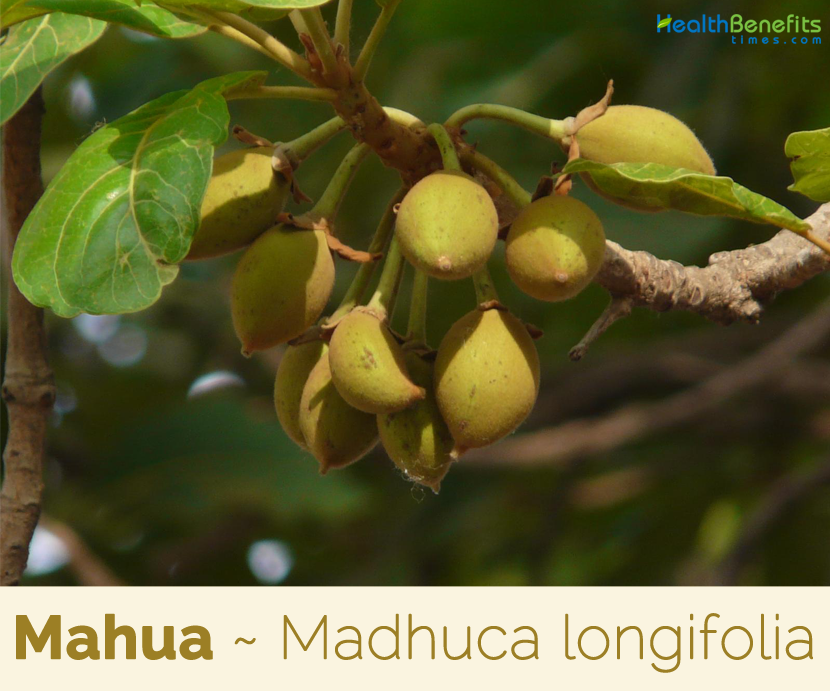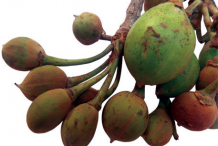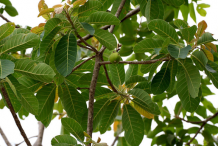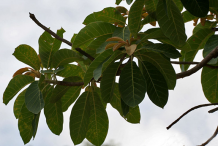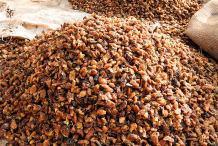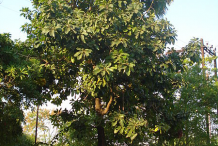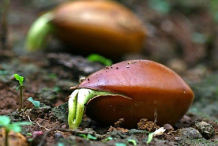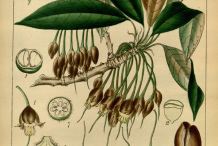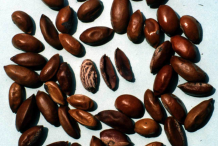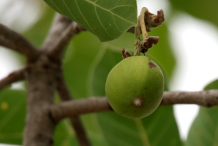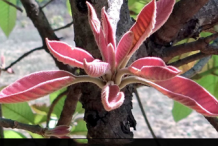| Mahua Quick Facts | ||
|---|---|---|
| Name: | Mahua | |
| Scientific Name: | Madhuca longifolia | |
| Origin | Northern, central and southern part of peninsular India, Sri Lanka and Burma | |
| Colors | Greenish when young turning to pinkish yellow when ripe | |
| Shapes | Fleshy berries, 2-6 cm long, ovoid having 1-4 seeds | |
| Taste | Sweet, astringent, bitter | |
| Major nutrients | Protein (12.74%) Total Fat (1.43%) Calcium (0.80%) Phosphorus(0.29%) |
|
| Health benefits | Beneficial for skin disease, rheumatism, headache, constipation, piles, hemorrhoids, chronic tonsillitis, heart disease and diabetes | |
| Parts of Plant | Morphology of leaves | Observation |
| Leaf | Color | Green |
| Odor | Characteristics | |
| Taste | Bitter | |
| Size | 11-15 cm long, 5-8 cm wide | |
| Shape | Lanceolate to ovate | |
| Texture | Short | |
| Fracture | Easy | |
| Apex | Acute | |
| Arrangements | Opposite | |
| Appearance | Smooth | |
| Petiole | Short |
Microscopical Character:
- Stem: Stems of Madhuca longifolia consists thin layered cell cork, cortex, epidermis, xylem, phloem, pith.
- Petiole: Petiole consist vascular bundle, xylem, phloem, endodermis, pericycle and pith.
- Leaf T.S.: Leaf T.S. consist cork, upper and lower epidermis, xylem, phloem and pith.
- Trichomes: Leaves consists uniseriate type of trichomes and covering trichomes.
- Stomata: Both lower and upper surface consist paracytic stomata.
Description of Some Species
1. Bassia Latifolia
It is a deciduous tree having 12-15 meter height. Bark is thick, dark colored, cracked, the inner bark red, milky, trunk short, branches numerous, spreading, forming a thick shady head. Leaves are clustered near the ends of the branches, coriaceous, hard and firm, elliptic or elliptic -oblong, shortly acuminate, pubescent or tomentose when young, at length glabrous, base rounded or acute. Petioles is long at first pubescent, ultimately glabrous or nearly so. Stipules are long, subulate, densely pubescent, vary caducous. Flowers in dense fascicles near the ends of the branches, below the terminal leaf-bud. Pedicels long, drooping, fulvous or rusty-pubescent or tomentose. Calyx is long, divided nearly to the base, segments ovate, sub-acute, rusty tomentose, usually 4 (rarely5), the two outer sub-valvate and enclosing the others. Corolla is cream colored, tube long fleshy, rugose, when dry, lobes 7-14 (usually7-9), ovate-lanceolate, acute, erect. Stamens 20-30 (usually 24-26), anthers in 3 series, acuminate, hairy at the back. Ovary is hirsute, style long and hairy at the base. Berry is long, fleshy, ovoid, greenish. It flowers in January-April under different climatic conditions.
2. Bassia longifolia
It is a large tree commonly found in south India. It has numerous branches, bark thick, dark brown, scaly, the inner dark red, milky, young parts pinkish white silky pubescent. Leaves are thin, clustered near the ends of the branches, linear lanceolate, acute, glabrous when mature, much tapered towards the base, petioles long slender, stipules long, linear subulate, hairy and caducous. Flowers appearing with the young leaves, in dense clusters near the ends of the branches below the leaves, pedicels long, glabrous, erect at first, afterwards more or less drooping. Calyx long divided nearly to the base, densely rusty pubescent, segments usually 4, ovate oblong, acuminate. Corolla is long, tube fleshy, in flatted, glabrous, rugose when dried, lobes 6-12, lanceolate, sub-obtuse and glabrous. Stamens 16-20 in 2 rows one above the other, sub sessile, anthers hairy, cordate at the base, the connective produced to a point. Ovary is densely hairy. Berry is oblong, the size of a plum, hirsute while young ultimately nearly glabrous, yellowish when ripe. Seeds 1-2, compressed, straight on one side, curved on the other. It flowers November-January.
3. Bassia malabarica
It is a medium sized tree. Bark is dark colored and scaly. Leaves are very coriaceous, oblong to lanceolate, sub-obtuse, glabrous, dark green and shining, base tapering, main nerves 15-25pairs,very slender with closely reticulate veins between, petioles long. Flowers are crowded towards the ends of the branches in dense fascicles. Calyx long, divided nearly to the base, segments 4, ovate, sub-acute, the 2 outer glabrous or nearly so, the 2 inner hairy. Corolla is long, tube densely rufous-hairy, both inside and outside, slightly shorter than the lobes. Lobes 6 or (rarely7), oblong, obtuse, fulvous-hairy outside. Stamens 16-18 in 2 rows, filaments are densely rufous-hairy, anther glabrous or with a very small tuft of hairs between the basal lobes, cordate at the base. Ovary is glabrous. Berry oblong- lanceolate, glabrous while young. It flowers November-January. It grows in Western Ghats from Kanara to Travancore and also in the Himalayas.
Variability in oil content, fatty acid pro file and bio diesel traits of mahua
| Parameter | Percent |
| Kernel oil | 52.5 % |
| Palmitic acid | 18 % |
| Stearic acid | 25.5 % |
| Oleic acid | 40 % |
| Linoleic acid | 12 % |
| O/L ratio | 3 % |
| Total saturated fatty acid | 45.5 % |
| Total unsaturated fatty acid | 53 % |
| Saturation ratio | 0.885 % |
| Saponification value | 200 % |
| Iodine value | 60 % |
| Cetane number | 59.5 % |
Health benefits of Mahua
Mahua has following health benefits:
- Oil extracted from the seeds of the Mahua plant is applied over the area affected with skin diseases and body pain.
- Nasal administration of the fresh juice of the flowers of Mahua is done in diseases of vitiated pitta dosha like headache, burning sensation of the eyes etc.
- Dried flowers of Mahua is boiled in milk and administered in a dose of 40-50 ml to treat weakness of the nerves and diseases of the neuro muscular system.
- Decoction prepared from the bark of the tree is given in dose of 30-40 ml to treat Irritable bowel syndrome and diarrhea.
- Fresh juice of the flowers is given in a dose of 20-25 ml to treat hypertension, hiccups and dry cough.
- Flowers of Mahua plant is boiled in milk and added with sugar candy and given in a dose of 40-50 ml to treat less sperm count, premature ejaculation and production of less milk in postpartum periods.
- Cold infusion prepared from the flowers or bark of the plant is given in dose of 30-40 ml to treat burning micturition, fever and burning sensation of the body.
- Cold infusion or milk boiled with flowers of the plant is beneficial to patients suffering from general debility.
- For rheumatism, decoction of bark prepared by boiling bark in water is taken internally and the seed oil is applied externally on the affected areas.
- Bark decoction is given for managing diabetes.
- Leaves are used in treatment of eczema. The leave are coated with Sesame oil and heated. This is applied externally on affected area to get relief from eczema.
- For spongy and bleeding gums, 4 ml of the liquid bark extract is mixed with 300 ml of water is used as a gargle. Gargling with bark extract is also useful in acute tonsillitis (inflamed tonsils) and pharyngitis.
- A cup of infusion of bark is taken orally twice a day to cure Diarrhea.
- Seed oil massage is very effective remedy for reducing pain.
- Stem bark powder, mixed with Gular latex is given in dose of five grams twice a day, with warm water for respiratory illness.
- Roots are ground and applied on ulcers.
- Mahua flowers are very nutritive and taken as a general tonic. For this purpose, the dried flower powder is eaten with ghee and honey.
Traditional uses of different parts of Madhuca longifolia
| Part(s) used | Ethno medical uses |
| Seeds cake | Anti-inflammatory, anti-ulcer, and hypoglycaemic activity |
| Bark | Anti-hyperglycemic, antioxidant, Antibacterial, anti-diabetic activity, Rheumatism, bleeding and spongy gums, ulcer and tonsillitis and Itch, swelling, fractures and snake-bite poisoning |
| Flower | Analgesic, Hepato-protective activity, skin diseases, Tonic, analgesic, diuretic and Cure cough |
| Leaves & bark | Wound healing activity |
| Leaves | Verminosis, gastropathy, Dipsia, bronchitis, dermatopathy, rheumatism, cephalgia, hemorrhoids, Nephro, hepato protective, Antioxidant, Cytotoxic and Anti-hyperglycemic activity and Expectorant, chronic bronchitis and cushing’s disease |
| Aerial part | Anti-inflammatory, analgesic and antipyretic activity |
| Seeds | Anti-inflammatory and Effective to alleviate pain |
| Leaves and stem bark | Astringent, Stimulant, Emollient, Demulcent, Rheumatism, Piles, Nutritive and Antimicrobial activity |
| Fruits | Asthma and phthisis |
Traditional uses and benefits of Mahua
- Mahua oil has emollient properties and is used in skin disease, rheumatism and headache.
- It is also a laxative and considered useful in habitual constipation, piles and hemorrhoids and as an emetic.
- Flowers have been traditionally used as cooling agent, tonic, aphrodisiac, astringent, demulcent and for the treatment of helminthes, acute and chronic tonsillitis, pharyngitis as well as bronchitis.
- Leaves are expectorant and also used for chronic bronchitis and cushing’s disease.
- Distilled juice of the flower is used in treatment of helminthes, acute and chronic tonsillitis, as well as bronchitis.
- Leaves are applied as a poultice to relieve eczema.
- Aerial parts are used for treatment of inflammation.
- Bark used as decoction for rheumatism, bleeding and spongy gums.
- Leaf was used in verminosis, gastropathy, dipsia, bronchitis, consumption, dermatopathy, rheumatism, cephalgia and hemorrhoids.
- Fat obtained from mahua seeds has much medicinal application.
- Seeds fat has emuluscent property, used in skin disease, rheumatism, headache, laxative, piles and sometimes as galactogogue.
- Bark is a good remedy for itch, swelling, fractures and snake- bite poisoning, internally used in diabetes mellitus,
- Fruits are astringent and largely used as a lotion in chronic ulcer, in acute and chronic tonsillitis and pharyngitis.
- Seeds are used as laxative in habitual constipation and piles, gummy juice applied in rheumatism and skin affection, oil used in skin disease.
- It is beneficial in impotence due to general debility when administered with milk.
- It has been used to treat infections, wounds, rheumatism, heart disease, diabetes and many other disorders.
- Powdered bark is used for the treatment of scabies.
Ayurvedic Health benefits of Mahua
- Bronchitis: Take dried Mahua Flowers. Powder. Have one teaspoon with one glass of milk.
- Ascaris: Make a decoction using bark of Mahua. Drink 30 ml once a day.
- Liver Congestion: Add quarter tsp bark powder of Mahua in a cup of lukewarm water. Have it once a day.
- Biliousness: Drink 10 ml bark decoction of Mahua thrice a day.
- Ulcers: Boil 3 g bark of Mahua in 50 ml water. Have it twice a day.
- Cardio Tonic: Take few flowers of Mahua. Make decoction. Drink 20 ml thrice a day.
- Piles: Fry few flowers of Mahua with Clarified Butter. Take 1 tsp twice a day.
- Expectorant: Consume half cup flower decoction of Mahua twice a day.
- Tuberculosis: Boil 10 g crushed fruit of Mahua in 100 ml water. Drink 20 ml twice a day.
- Galactogogue: Add 1 tsp Mahua seeds in a cup of water. Boil. Drink once a day when bearable hot.
- Orchitis: Soak leaves of Mahua in boiled water for half hour. Tie them on Testes.
- Gum Diseases: Use bark decoction of Mahua as Mouth wash
- Insufficient Breast Milk: Mahua helps to produce more milk. You need to boil 5 grams of Mahua seeds in a cup of water. Strain. Have it lukewarm once a day.
- Bronchitis: Flowers of Mahua are used to treat chronic bronchitis problem. Flowers are also used in treatment of cough.
- Rheumatism: A decoction is prepared by boiling bark in water and taken internally to get relief from rheumatism. Oil obtained from seeds can also be applied on the affected areas.
- Diabetes: Bark decoction is proven to be effective for cure of diabetes.
- Piles: Oil extracted from seeds have laxative properties, which helps cure chronic constipation and piles.
- Gums: 4 ml of the liquid extract obtained from bark is mixed with 300 ml of water is used as a gargle to get relief from spongy and bleeding gums.
- Tonsillitis: The above preparation is also used for cure of chronic and acute tonsillitis and pharyngitis.
- Burns: Leaves ash is mixed with ghee and is used for cure of scalds and burns. To get relief from itching, bark paste is applied locally.
- Rheumatism: A decoction of the bark can be given internally in rheumatic diseases. The oil extracted from the seeds can also be applied locally on the affected area.
- Diabetes: A decoction of the bark can also be taken in diabetes mellitus with beneficial results.
- Problem of Breast Milk Secretion: Flowers of the tree are effective in increasing the milk in nursing mothers. The seeds also have a similar propel.
- Eczema: Leaves of mahua are effective in the treatment of eczema. The leaves, smeared with sesame oil, warmed over a fire and bandaged on the affected parts provide relief. They should be changed after every 3 to 4 hours.
- Skin Disorders: Ash of the leaves, mixed with ghee, is often used as a dressing for burns and scalds in the indigenous system of medicine. For the cure of itching, a paste of the bark is applied locally. The oil extracted from the seeds can also be applied locally in skin diseases.
Parts wise use of Madhuca longifolia
| Parts of plant | Medicinal Properties |
| Leaves | Wound healing, hepato-protective, antioxidant, antimicrobial, astringent, stimulant, emollient, demulcent, rheumatism, piles, nutritive, verminosis, gastropathy, dipsia, bronchitis, dermatopathy, cephalgia, hemorrhoids and Cushing’s disease |
| Root | Antipyretic, anti-inflammatory, antioxidant, phthisis and scrofula, diarrhea and chronic fluxes |
| Flower | Tonic, analgesic , diuretic, cooling agent, aphrodisiac, astringent, demulcent, helminthes, acute and chronic tonsillitis, pharyngitis as well as bronchitis |
| Fruit | Astringent, lotion in chronic ulcer, acute and chronic tonsillitis and pharyngitis. |
| Seeds | Emuluscent, skin disease, rheumatism, head ache, laxative, piles and galactogogue |
| Bark | Itch, swelling, fractures, rheumatism, bleeding spongy gums, ulcer and tonsillitis, skin diseases, epilepsy, pneumonia and piles |
Other Common Uses of Mahua
- Fodder: Leaves, flowers and fruits are lopped for goats and sheep. Seed cake is also fed to cattle.
- Timber: The heartwood is reddish brown, strong, hard and durable; very heavy (929 kg/cu. m), takes a fine finish. It is used for house construction, naves and felloes of cartwheels, door and window frames
- Erosion control: Mahua has a large spreading superficial root system that holds soil together
- Shade or shelter: The wide spreading crown provides shade for animals. Reclamation: Mahua is planted on wasteland with hard lateritic soils in India.
- Nitrogen fixing: Vesicular-arbuscular mycorrhizal associations and root colonization have been observed in mahua.
- Soil improver: The seed cake has been used as fertilizer
- Ornamental: Mahua is occasionally planted as an avenue tree.
- Boundary or barrier or support: It is planted along the boundaries of fields.
- Intercropping: M. latifolia can be raised with agricultural crops.
Culinary Uses
- Mahua flower is edible and is a food item for tribal. They are used to make syrup for medicinal purposes.
- They are also fermented to produce the alcoholic drink mahuwa, country liquor.
- Mahua flowers are also used to manufacture jam, which is being made by tribal cooperatives in the Gadchiroli district of Maharashtra.
- Mahua seeds can also be used for preparation of defatted flour, which has great potentiality in bakery products.
- Flowers may be crushed and blended for use in sauces and compotes.
- Boiled mahua and tamarind make a sweet concoction used as a quick source of calories.
Other facts
- Plant produces between 20 and 200 kg of seeds annually per tree, depending on maturity.
- Fat is used for the care of the skin, to manufacture soap or detergents, and as a vegetable butter.
- It can also be used as a fuel oil.
- Seed cakes obtained after extraction of oil constitute very good fertilizer.
- Flowers are used to produce an alcoholic drink in tropical India. This drink is also known to affect the animals.
- Bark is considered holy by many tribal communities because of its usefulness.
- Tree is considered a boon by the tribal who are forest dwellers and keenly conserve this tree.
- Tree matures and starts bearing at 8-15 years and fruits up to 60
- Mahua oil is used in manufacture of soap, lubricating grease, fatty alcohols and candles.
- Flowers are also used in preparation of distilled liquor, portable spirits, vinegar and feed for livestock.
- Flowers show anti-bacterial activity against E. coli and also are used against rice pest diseases.
- Mahua flowers contribute as most important raw material for alcohol production.
- Leaves are used for making plates for various purposes.
- Cake obtained after extraction of oil is used as manure and has insecticidal properties.
- It provides quality timber wood for various uses.
- Leaves are fed on by the moth Antheraea paphia, which produces tassar silk, a form of wild silk of commercial importance in India.
References:
https://www.itis.gov/servlet/SingleRpt/SingleRpt?search_topic=TSN&search_value=505956#null
https://davesgarden.com/guides/pf/go/191053/
https://npgsweb.ars-grin.gov/gringlobal/taxonomydetail.aspx?id=23083
https://plants.usda.gov/core/profile?symbol=MALO5
http://www.theplantlist.org/tpl1.1/record/kew-117250
https://pdfs.semanticscholar.org/ab9d/af220dc226030fff7c5bf143a8872fe1bc39.pdf
http://www.ijhssi.org/papers/v2(5)/version-3/F253036.pdf
https://en.wikipedia.org/wiki/Madhuca_longifolia


